Menu
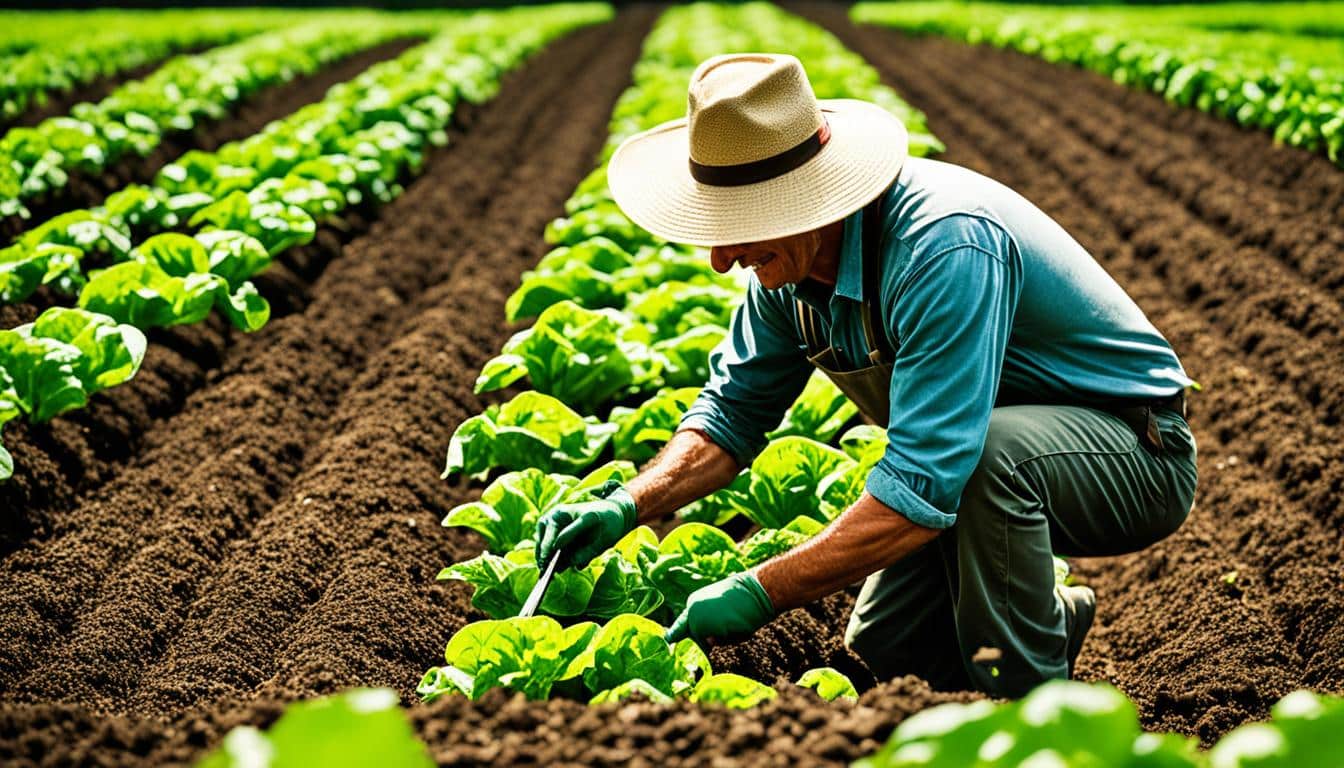
Did you know soil can erode much faster than it forms in industrial farms? Rates can be 10 to 100 times higher. This fact shows how urgent it is to use sustainable methods in agriculture.
To reduce chemical use in farming, we need to focus on green methods that support the earth. It’s important to find a balance between making money and keeping the environment healthy. This way, farmers can use new ways to make their farms stronger, needing fewer synthetic chemicals.
The move to cut down on chemical farming is a big change for agriculture. It shows we understand the need for farming that works with nature. We’ve realised farming can be done in a way that is friendlier to our planet. This new approach looks at making food and its effects more broadly. Now, we’re looking for ways to farm that are good for us and the earth.
Many now see organic farming as the way to go. It helps the environment and keeps us from using too many chemicals. Industrial farming has caused our soil to wash away quickly, much faster than it naturally builds up. This is a sign we need to farm in ways that keep our soil healthy and stop using too many man-made chemicals.
There have been big changes in farming in the United States. Back in 1920, there were a lot more Black farmers than there are now. Today, White farmers own most of the farming land. This shows things need to change to include everyone and focus on farming that helps all different kinds of people.
Farming has a lasting impact on our world. We now know that using many kinds of chemicals in farming can hurt our environment and health. Scientists have spent lots of time looking into how these chemicals affect things like the soil and the water. Now, they’re trying to find better ways to farm that don’t use so many harmful chemicals. This includes things like making the soil healthier and using less water.
When we farm in a sustainable way, we all benefit. It means the food we eat is safer, especially for those who struggle to afford food. This is really important now because of certain events that have made food more expensive for some people.
| Stages of Research | Focus Areas | Environmental Media |
|---|---|---|
| Early Stage (1990–99) | Pesticides, Veterinary Drugs | Soil, Water |
| Middle Stage (2000–07) | Fertiliser Application, Monitoring | Soil, Water |
| Late Stage (2008–16) | Impact Assessment, Pollution Prevention | Soil, Water |
Regenerative agriculture is all about a different way to look at farming. It joins everything together, focusing on how different parts of the farm work with each other. This way, we take care of the soil, make sure there’s lots of different plant and animal species, and treat everyone fairly.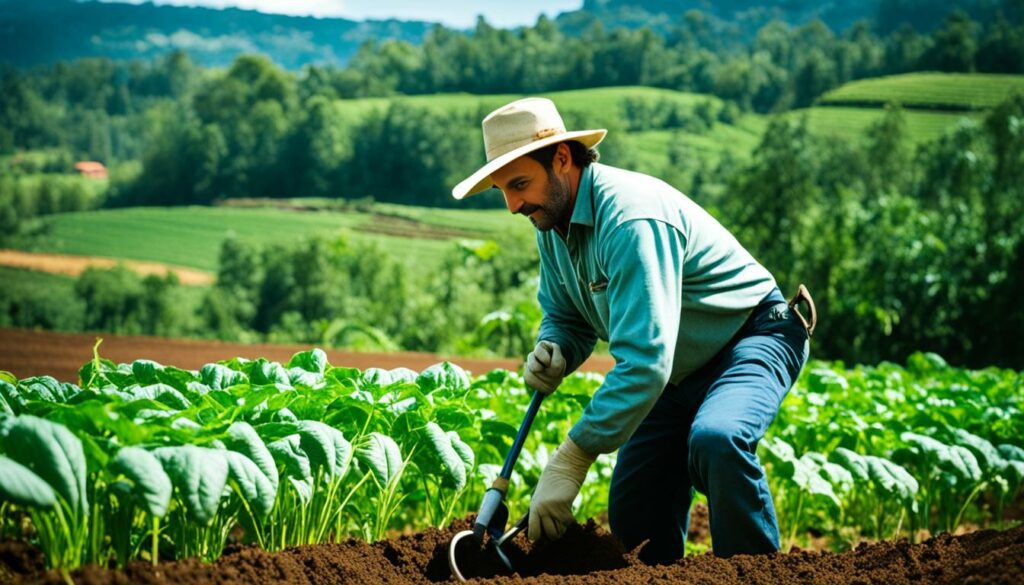
This type of farming aims to use less chemicals and bring the soil back to life. It wants to have lots of living things in and around the farm and keep everything in balance. Farmers use methods that protect the soil, stop it from washing away, and keep too much fertilizer out of the water.
This kind of farming doesn’t just measure success by how much food comes from the farm. Farmers find happiness in seeing the land heal and making sure lots of families have enough to eat. It makes the farm strong against bad weather and hard times.
Regenerative farming has its roots in old ways of farming that people all over the world have used for a long time. These ways fit well with modern ideas about farming. Using more than one type of crop together, and planting trees with crops are some practices that still apply today.
In the US, in 1920, there were close to a million Black farmers. Now, there are only about 45,000. Most of the land is owned by White farmers. This shows a problem with who can own land. Fixing these past unfair situations is key to making regenerative farming fair for everyone.
Regenerative farming points towards a better way to get our food. It uses old and new ideas to farm well without hurting the planet. With these methods, we can have a strong farming system that takes care of the Earth and shares food with everyone.
Soil health is key for successful agriculture and a healthy planet. It greatly affects the environment and our food supply. Strong soil health is vital for both sustainable farming and boosting crop growth.
Not disturbing the soil keeps its vital life intact. No-till farming helps cut down on some greenhouse gases, but it doesn’t keep soil carbon forever. Cover crops are essential. They can stop soil from washing away, lower nutrient loss, fight weeds, boost soil health, and ramp up its life variety. Farmers often choose legumes in cover crops. They help capture nitrogen and release it slowly, which means less loss and more benefit over time.
Using many plants together in cover crops makes soil life richer. This is especially true for farmers growing crops year after year in the same place, like trees or vines. They attract helpful insects and keep the ecosystem in balance. Newer practices in weed control, like not tilling, using cover crops, rotating crops, and pressing them down, show promising results.
Healthy soil is every farmer’s best friend. Just look at fields in southern Europe and Asia, farmed for centuries. Here, balanced soil has kept crops growing strong. Plants that enrich the soil with nitrogen, like legumes, are vital. They offer extra nitrogen for other plants to use, making farming more efficient.
In the US, windbreaks are a smart soil-saving solution. These barriers of trees and shrubs slow the wind down, protecting soil from eroding. They make soil healthier and boost its ability to support plants. Mixing different crops together can also make the land more inviting for beneficial birds and insects. This creates a more natural cycle where the land helps itself.
Soil loss is a big issue, especially in places with heavy farming. Often, soils disappear faster than they can naturally rebuild. By focusing on keeping soils healthy, we can have more food while preserving the land for the future. Strong soil means better farming, which is important for feeding the world in a way that doesn’t damage the earth.
Using natural ways to battle pests on farms can cut down on chemical use. This is good for our planet and helps crops grow stronger. Bio pest control and diverse crops are key.
At the core of natural pest control are biological methods. Good bugs and natural enemies help farmers fight pests without chemicals. The USDA’s Organic Rules allow adding predators or creating spaces for them. The Organic System Plan details how to use these methods effectively.
Using traps and barriers is another way to control pests. By adding these to organic farming, along with managing soil and nutrients well, pests can be kept at bay.
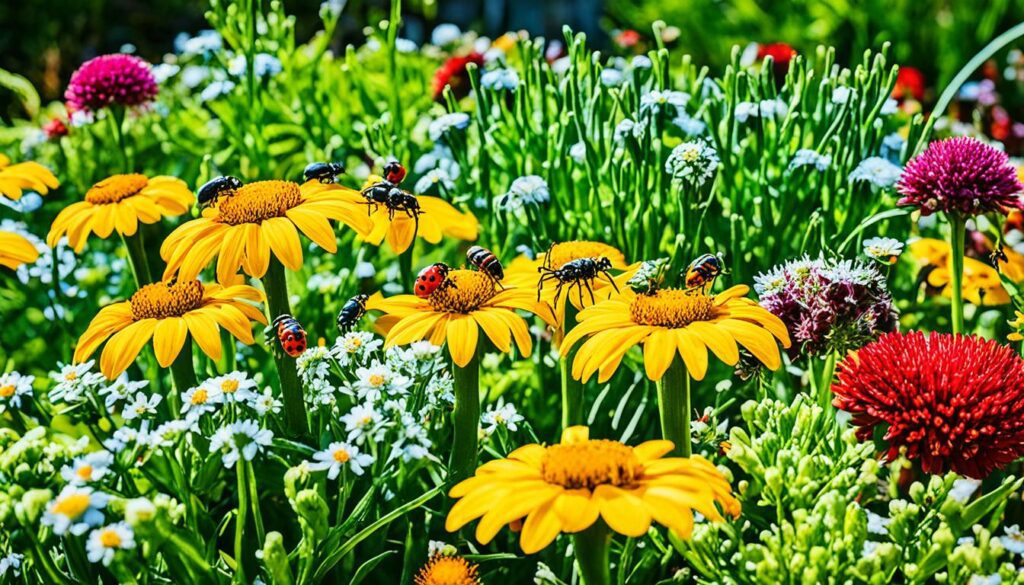
Pairing certain plants and growing different ones together is vital for pest control. This mix cuts down pests, weeds, and diseases, making the farm healthier. Rotating crops and doing tasks like mulching and weeding also help.
Planting the right mix can bring good bugs that help pollinate. This is crucial in organic farming. It not only boosts soil and plant health but also lowers the need to till land. For more on this, check out eXtension.org.
Using fewer pesticides is crucial for both the environment and our health. By choosing alternatives to chemical pesticides, we can lower their bad impact.
One way to use less pesticide is by switching to natural methods. This involves letting natural predators control pests. It also means using organic pesticides and planting different crops together.
| Country | Alternative Methods Used | Results |
|---|---|---|
| Thailand | Biological control, crop rotation | Less pesticide, healthier crops |
| United States | Organic pesticides, companion planting | Less need for pesticide, more biodiversity |
| Austria | No pesticides, increased organic matter | More ground beetles |
In Thailand, strong policies reduced pesticide use and improved agricultural health. It’s an example that other places could follow.
The United States has also made progress. They’ve cut down on the amount of pesticides used. This happened through better rules and worker training.
Many countries have seen good results by using fewer pesticides. For example, Austria has more ground beetles in the fields they don’t use pesticides on. The UK has found that fewer nitrogen applications help earthworms, which is good for the ecosystem.
Looking into new ways to fertilise can improve our soil and enhance crop growth. This approach cuts down the need for harmful chemicals. Instead, it uses natural methods and substances, making farming more sustainable.
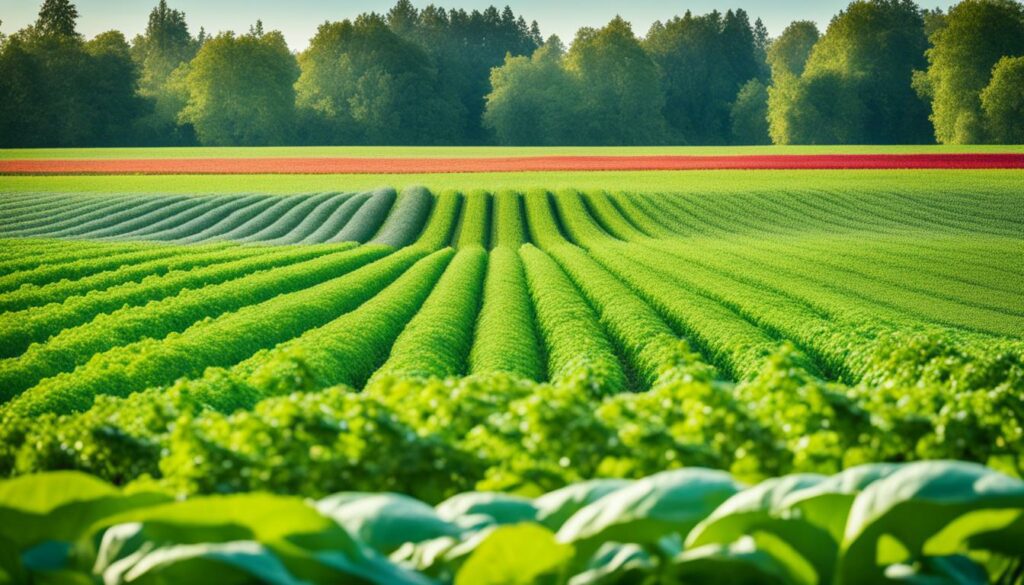
Cover crops are key in these new fertilisation methods. For example, planting white lupine lets farms use biological nitrogen fixation. As a result, crops and pastures worldwide get up to 65% of their nitrogen from this. In Florida, using white lupine as a cover crop led to peak cotton yields with 57% less nitrogen fertilizer.
In organic farming, practices like cover cropping are crucial. They maintain soil fertility and improve its function over time. Growing different types of cover crops helps organic farms cope better with challenges. This makes the soil more stable and productive.
Composting and handling manure are also very important. Correctly using manure adds key nutrients like nitrogen, potassium, and phosphorus to the soil. This way, the soil gets richer the natural way.
Compost is great for soil health too. It boosts organic matter, makes soil hold water better, and helps plants get more nutrients. Using compost in the soil rejuvenates it. This leads to healthier crops and takes care of the environment.
These fresh fertilisation approaches can keep fields fruitful without relying so much on chemical fertilisers. For a full guide on how to start, check out this resource.
Integrated pest management (IPM) brings together many ways to control pests in a good-for-the-planet and money-wise way. Started over 50 years ago at UC, this strategy has become a science-based go-to for dealing with pests. It aims to use less chemicals by using a mix of methods.
IPM uses different methods like changing how crops are grown, using bugs that eat other bugs, and setting up physical barriers. This mix helps farmers cut down on possibly harmful chemicals and protect the environment. UC’s IPM team, which first looked at nine key crops in California, has developed these ways.
Farmers can change when and where they plant to throw off pests’ timing and use crops that pests don’t like. They can pick pests off by hand or put up fences to keep them out. All these approaches help reduce the need for chemicals in farming.
Keeping an eye on pests and choosing the best way to manage them are key in IPM. UC IPM’s help extends to spotting new pests and tree pests, making sure farmers have the tools they need. Knowing when and how many pests are around helps farmers choose the best actions.
The best results come from combining methods, as guidelines advise. The UC IPM website has tools to help with these choices, like calculators and guides for safe use of treatments. This information is crucial for farmers to make smart, nature-friendly choices.
| Control Method | Example | Benefit |
|---|---|---|
| Biological Control | Natural Predators | Minimises pesticide use |
| Cultural Control | Crop Rotation | Breaks pest life cycles |
| Mechanical Control | Traps and Barriers | Physically removes pests |
IPM works best when farmers combine methods and make choices based on solid information. This way, they can effectively handle pests without using too many chemicals. This is good for the planet and their pockets.
Crop rotation is key to sustainable farming. By changing the plants in each field, farmers get many benefits. This includes managing pests better, making the soil richer, and improving how the soil holds together. Knowing these advantages shows why crop rotation is essential in farming.
Crop rotation is great at stopping pests and diseases. When farmers rotate crops, it breaks the pests’ patterns and reduces their numbers. For example, if you switch from maize to legumes, you can cut down on maize rootworms. This approach reduces the need for harmful chemicals, making the farm’s ecosystem healthier.
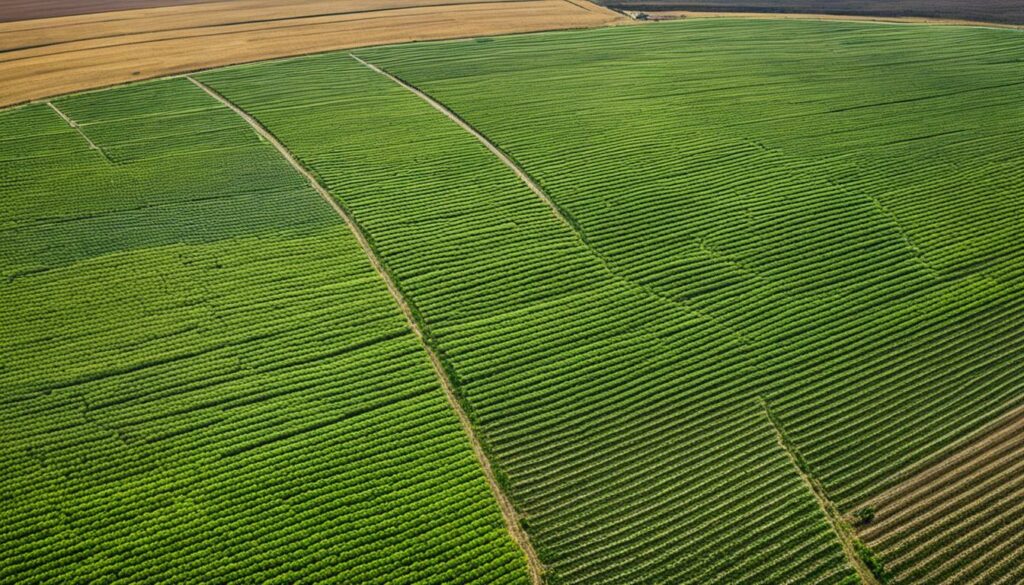
Crop rotation boosts soil health in a big way. Each crop needs different nutrients, and this helps keep the soil balanced. Planting legumes, for instance, can up the soil’s nitrogen without needing chemical fertilizers. This also makes the soil better for plants to spread roots, take in water, and breathe.
Also, growing plants that leave a lot of waste can stop the soil from washing away. This keeps the topsoil rich and full of the nutrients that plants need. Over time, crop rotation means better harvests and less risk, making farming more sustainable and profitable.
Adopting sustainable farming methods is crucial for long-term success. Agroforestry and permaculture are two key practices. These methods help improve productivity and the environment.
Agroforestry is about planting trees and shrubs in farming areas. It’s great for the ecosystem. This method helps manage water by reducing soil erosion and filling up the groundwater. It also brings in extra money through selling fruits and nuts.
Permaculture is all about using the land wisely with minimal waste. It supports a system that can renew itself. Both methods are good for nature and help communities and farms thrive.
It’s key to use water in farming wisely. Drip irrigation uses 20-40% less water than traditional methods. This can also make crops grow better by 20-50%. Such steps are important to keep the soil healthy and stop erosion. They also cut down the use of harmful chemicals in farming, making food healthier.
| Practice | Water Savings | Crop Yield Increase |
|---|---|---|
| Drip Irrigation | 20-40% | 20-50% |
| Furrow Irrigation | 0% | 0% |
Using these methods doesn’t just help the environment. It also makes farms work better and earn more.
Using eco-friendly farming is vital for our agricultural future. It includes using renewable energy and cutting back on carbon. These steps improve our farm productivity and help our planet stay healthy.
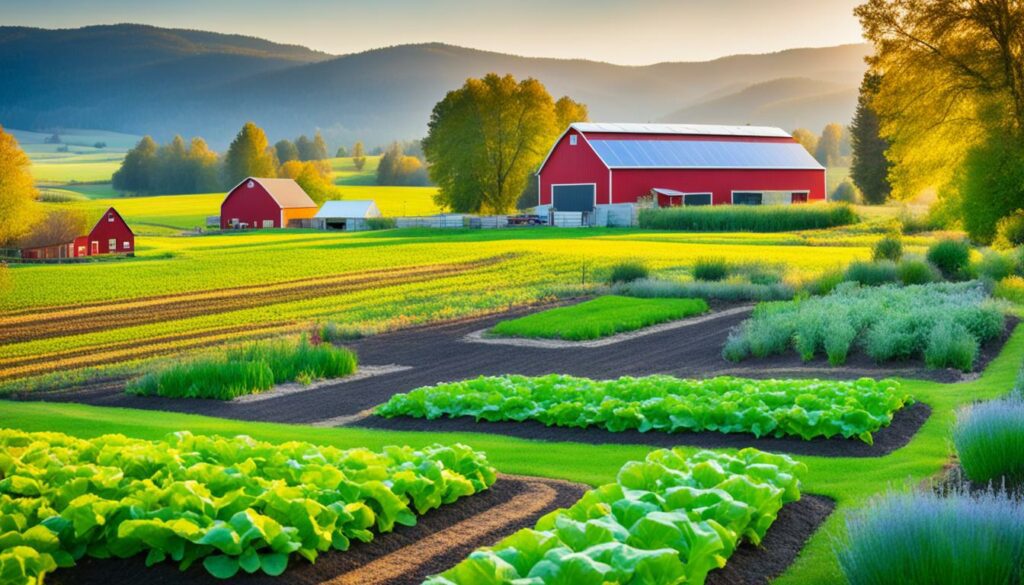
Solar panels, wind turbines, and bioenergy are changing farm work. They let farmers use less oil, spend less money, and release fewer gases. This change supports both the Earth and our wallets by keeping energy costs stable and offering more jobs in the countryside.
There are many ways to use less energy on our farms. No-till farming, cover crops, and farming alongside trees help a lot. These methods keep our soil healthy and reduce harmful emissions. Also, using less chemical pesticides and combining animals and crops saves energy and cuts waste.
| Farming Technique | Environmental Benefit | Economic Advantage |
|---|---|---|
| Renewable Energy Adoption | Less need for oil | Keeps energy costs steady |
| Cover Cropping | Stop soil loss and adds nutrients | Less use of chemicals |
| No-Till Farming | Less soil loss and better soil | Less spending on labour and machines |
| Agroforestry | Protects water and animals | More ways to earn |
These techniques make our farms strong and good for the future. Using renewable energy and cutting back on carbon help fight climate change.
Flavonoids are key secondary metabolites in plants, essential for their health. They help in taking in nutrients, control how plants work, and protect them naturally. Found mainly in the part of the soil surrounding plant roots, flavonoids benefit both plants and the soils they grow in.
In farming, flavonoids are crucial for getting plants to fix nitrogen from the air. This is important because it lowers the need for chemical fertilisers. Flavonoids work with special bacteria in the soil – rhizobia. They help enhance the process of getting nitrogen from the air into the soil and then to the plants.
During the important stages when plants develop what we call nodules, these compounds help stop the movement of an important plant hormone called auxin. This is critical for the plant to get ready for the bacteria to start helping it fix nitrogen.
Rhizobial Nod factors induce the synthesis of flavonoids in host plants that interfere with auxin transport, potentially leading to altered hormonal concentrations at the site of infection.
Flavonoids have a big impact on the health of the soil. They help with the cycling of nutrients and even cause structures like nodules to form on plant roots. These effects mean plants don’t need as many chemicals, which is better for both the soil and the plants. For example, without proper flavonoids, plants like M. truncatula don’t nodulate as well and show signs of high auxin movement.
Using flavonoids can also lessen the need for synthetic fertilisers. Products such as CropBioLife, with their high flavonoid content, help plants take in nutrients better. This reduces the need for artificial fertilisers. It’s good for farmers’ budgets and the Earth. Research found that flavonoids help a certain type of soil bacteria, Sinorhizobium meliloti, fix nitrogen better without more chemical fertiliser.
Scientists keep studying flavonoids to find those that could help plants without needing a lot of chemicals. This ongoing research aims to boost crop growth naturally. By using flavonoids in farming, we can create systems that are good forthe environment and farm productivity.
Below is a comparative table displaying the roles and benefits of flavonoids in agriculture and their impact on reducing fertiliser dependency:
| Role of Flavonoids | Benefits | Impact on Fertiliser Dependency |
|---|---|---|
| Enhance nutrient absorption | Improves plant metabolism and growth | Reduces need for synthetic fertilisers |
| Regulate plant metabolism | Boosts natural defence mechanisms | Decreases dependency on chemical inputs |
| Provide natural defence against pests | Protects crops from diseases and pests | Limits pesticide usage |
| Aid in nitrogen fixation | Supports soil health and fertility | Significantly cuts down on chemical nitrogen |
Reducing chemical inputs in farming is good for the planet. It also saves lots of money. Farmers using sustainable methods can reduce costs and stay stable financially.
Sustainable farming cuts costs. Less chemical fertilisers and pesticides mean lower bills. Research in China over 54 years found that using fertilisers smartly can save a lot. Also, a study on maize in Northeast China shows we can use less fertiliser without hurting crops.
Long-term, sustainable farming makes more money. In Southwest China, using eco-friendly tech brought more profit. China’s “zero-growth pesticide policy” is a good example. In Zhejiang, rules were made to use less chemicals without losing money or food. These steps help farmers do better financially.
| Benefit | Data | Impact |
|---|---|---|
| Input Cost Savings | Decreased by 30% in Northeast China | Immediate financial relief |
| ROI in Organic Agriculture | Adoption of low-carbon technologies | Increased profitability |
| Policy Impact | Zero-growth pesticide policy in China | Economic and environmental gains |
Less chemicals make financial sense. Sustainable farming can help the environment and the bank account. It brings immediate savings and long-term benefits.
Building good ecosystem relationships is key to successful farming. It means connecting plants, animals, and the environment in a way that supports each other. This leads to stronger, greener farms that rely less on harmful chemicals.
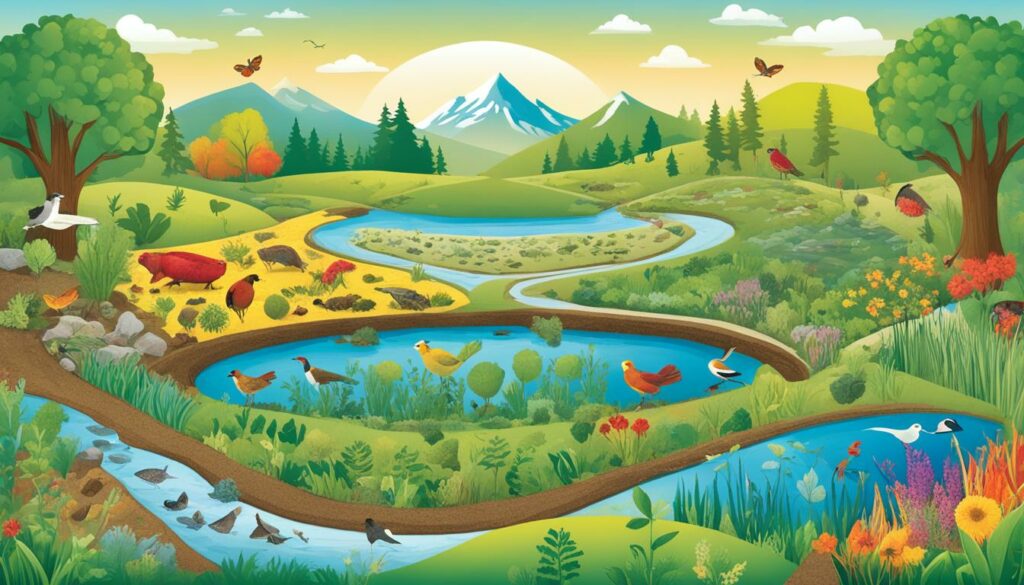
Linking livestock and crops together has many positives. It’s called livestock-crop integration. This method helps in recycling nutrients. For example, animals eat parts of crops, then their waste fertilises the soil, making it healthier. This cycle means less need for chemicals. Farms that use this method have better soil, keep more water, and grow more food.
This approach makes farming more efficient and sustainable.
Adding diversity to farms helps nature work better. It brings a variety of plants and animals together. They help control pests, pollinate plants, and handle bad weather. This makes the farm more lively and resistant to problems without using many chemicals.
Such farms also store more carbon from the air, which helps fight climate change. Plus, planting trees and protecting wild areas on the farm do even more to take in and keep harmful carbon away.
Diverse farms are healthier for people and the planet. They boost the economy by creating jobs and offering better food. The government is supporting this type of farming to make it fairer for everyone. Everyone Wins!
So, combining livestock and crops, and adding biodiversity are vital in making farming last. They help create a farming world that is balanced and enriching without the heavy use of chemicals.
Looking at real successes teaches us how organic farming can be good for the earth. Examples from many places show the clear benefits of using fewer chemicals.
In China, using lots of chemicals caused problems like water pollution. But, they took action. By 2020, they aimed to use the same amount of these chemicals but produce no more crops. Even with less fertiliser, they still grew the same amount of food. This shows cutting down on chemicals works, and the environment gets better.
The U.S. managed pesticide use better after the 1972 FEPCA. They found pesticides in almost all water tested near farms. This shows we need to keep looking for new ways to farm that are safe for the long run.
These case studies taught us a lot. The EU and China have set good rules for better fertiliser use. They cut down on big stocks of extra fertiliser, showing us how to manage our resources well.
Learning from livestock also helps. We can use animal waste for organic fertilisers, which is good for the planet. Preventing pollution is key.
“On average, every kilo of fertilizer (pure nutrient) input can increase grain production by 7.5kg. However, agricultural non-point source pollution caused by these chemicals leads to the loss of 0.5%-1% of China’s GDP annually.”
| Country | Strategy | Outcome |
|---|---|---|
| China | Zero growth initiative, increased utilisation rate | Stabilised grain production at ~650 million tons |
| USA | Federal Environmental Pesticide Control Act (FEPCA) | 97% pesticide detection in streams addressed |
| EU | Regulation EC No. 2003/2003 | Enhanced safety and reduced environmental impact |
In the end, these studies show us how to farm in a better way. Following their lead, we can produce food and protect our planet at the same time. This is the goal for farming in the future.
Understanding the social and historical context of agriculture is key. This is especially true when talking about using fewer chemicals. Farming has changed over time due to many reasons, including social and economic factors. These changes have sometimes led to unfairness in the farming world. Knowing this history helps us tackle these problems.
Problems like unequal farming practices have been around for a long time. For example, while there were nearly one million Black farmers in 1920, today there are only about 45,000 left in the U.S. And, most farmland is owned by white farmers. This shows why it’s so important to make farming fair. Everyone should have equal chances to get land, training, and support.
| Year | Total Farmers in the U.S. | Number of Black Farmers | Percentage of Land Owned by White Farmers |
|---|---|---|---|
| 1920 | 6.4 million | N/A | N/A |
| 2023 | 3.4 million | 45,000 | 98% |
There’s an urgent need to make farming fairer, especially with global issues at hand. Over 7% of people in Europe can’t afford certain meals regularly. This shows that our food systems need to be more resilient and fair. Current farming challenges are having a big impact on people.
Policy support for farming should meet today’s needs and correct old wrongs. The EU has set up strategies and policies to make farming more sustainable and fair. They are working to help all farmers use sustainable methods without relying so much on chemicals. This is a step towards fairer and more sustainable farming.
Furthermore, many groups are working together to change farming and food systems for the better. They are coming up with new plans and policies to make farming fair and good for the planet. One approach is regenerative farming, which is better for the earth and brings fairness to farming. This strategy helps not just the environment but also farmers in need.
Fixing farming’s past mistakes and choosing the right policies is crucial for a better, chemical-free farming future. By looking back at history, we can steer farming towards a more sustainable path. This will give all farmers a chance to succeed in a way that’s good for everyone.
It’s crucial to use regenerative agriculture to reduce chemical use in farming. This method offers many benefits for the environment and the wallet. It fights the damage caused by industrial farming, where soils are eroding quickly.
After talking to farmers across the U.S., it’s clear diverse methods are key to fighting climate change. These farmers focus on keeping their soil healthy and use less harmful chemicals. They measure success by how well they look after their land and communities.
Reducing chemical use brings several benefits:
| Factors | Benefits |
|---|---|
| Water Pollution | Less use of chemicals means water is cleaner, and there are fewer harmful algal blooms. |
| Cost Efficiency | Using fewer antibiotics and chemicals saves a lot of money. |
| Financial Security | Farmers make more and their communities are stronger due to various income sources. |
| Biodiversity | More kinds of plants and animals live well together on these farms. |
Black farmers face unique struggles, like less access to land and help services. Most land is owned by white farmers now. Making farming fairer is essential for a better food system for all.
The big goals of regenerative agriculture are to grow food in ways that are healthy for the Earth. This means using less artificial stuff and protecting our water. Our aim is to feed everyone while keeping our lands healthy for the future.
In the last thirty years, we’ve made big steps in using fewer chemicals in farming. During 1990 to 2016, researchers found out the bad effects of chemical fertilizers and pesticides. They harm the environment when used in growing food crops and fish farms. We now know it’s key to stop pollution, manage nitrogen and phosphorus, and reduce the spread of harmful chemicals.
China uses the most fertilizers and pesticides but only about a third actually help. Also, a lot of China’s farmable land is dirty, and nearly half its underground water is not safe. This shows why we need to control pollution better. In the USA, pesticides are common in farm water, found in almost all cases.
Even with these issues, about 40,000 farms in Italy are doing better with the environment by using fewer chemicals. But using less has made things tough for some small farms. So, we need special plans and government help for these farmers. Conservation Agriculture is one great idea, now used on 90 million hectares worldwide. It helps save water in the soil and uses less energy.
Moving forward, we need to keep supporting new genetic and tech ideas. We should also use farming ways that don’t harm the soil, like not ploughing the land. This will help our planet and make sure we can feed more people in the future.
By using fewer chemicals in farming, we preserve the environment and keep people safe. This way of farming, known as sustainable agriculture, also looks after our economy and the planet.
Organic farming does not use man-made chemicals. It focuses on natural ways to keep the soil healthy and protect nature. This is different from usual farming, which often turns to chemicals for help.
Regenerative agriculture aims to heal the land and be fair to everyone. It uses traditional farming wisdom while also being mindful of the environment. This approach creates strong and lasting farming systems.
Soil is vital for growing the food we need, and keeping the land healthy. By caring for the soil without disturbing it too much, we make sure it stays fertile. Healthy soil helps crops grow well without too many chemicals.
Natural pest control uses nature to keep pests in check. Methods like planting specific crops together or encouraging many different plants can work well without the need for harmful chemicals. This reduces our reliance on pesticides.
To use less pesticide, farmers can mix different strategies. They can use natural enemies of pests, change the crops they plant, and not grow the same crop in the same field every year. These methods lower the amount of harmful pesticides used.
Instead of just relying on artificial fertilisers, farmers can use different approaches. Cover crops, compost, and careful use of animal waste can make the soil better. This way, we rely less on chemicals to grow our food.
IPM is about smart pest control that looks at all the options. It doesn’t just use chemicals but also considers cultural and biological methods. By keeping an eye on pests, farmers make choices that use less harmful chemicals.
Crop rotation is good because it breaks the chain of pests and diseases. It helps the soil stay full of nutrients and strong, making it harder for pests to attack. This means farmers can grow food with fewer chemicals.
Agroforestry and permaculture help the land and the wildlife thrive. By mixing trees with crops and adopting careful farming methods, we save water, encourage more plants and animals, and use fewer harmful chemicals. This makes our farming more sound and able to endure changes.
Using energy from sources that don’t harm the planet is key. It helps farms do their part in fighting climate change and protects the environment. This makes farming more sustainable in the long run.
Flavonoids are good for plants because they help absorb nutrients and fight off pests. By using products with flavonoids, we can cut down on the need for chemical fertilisers and pesticides. This is better for the health of plants and for the environment.
Using fewer chemicals not only saves money for farmers but also makes their farms more profitable over time. It’s a win-win situation for the environment and their wallets.
Having animals and crops work together helps the land stay rich. It increases the variety of life on the farm and makes farming systems more robust. This is important for the health of the farm and the people who depend on it.
Looking at different farms around the globe shows us the success of sustainable ways of farming. These success stories teach us about the best ways to lower chemical use while still growing plenty of food. They show that it can be done.
Being fair and having the right support is key to more farms using sustainable ways. Good policies and help for farmers give them what they need to use fewer chemicals. This ensures that everyone has a chance to farm in a way that is good for people and the earth.